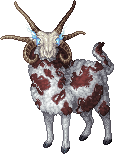


General
Polyceras sheep find great comfort and safety in their flocks, which are usually led by the largest ram. These creatures hail from the Silva forest, where the soft grasses and leaf litter silence their footsteps. Larger than most sheep and more difficult to care for, polyceras are nonetheless popular companions. They always possess six horns, a trait unusual among sheep. Both ewes and rams are relatively docile and both share parental responsibilities. Polyceras rarely attack anything, preferring to flee as soon as they can unless cornered. They have little magical ability, but occasionally have been known to cast weak defensive spells of water or earth elemental origin. Bones, typically horns, are thought to be powerful additives in defensive potions. Earth magi are most likely to befriend a polyceras.
Egg
Six horns poke through the shell of this egg.
Hatchling
Polyceras lambs are naive, willingly wandering away from their mothers to investigate most anything. This typically is not a concern for the flock, as these lambs are quite speedy and can outrun many predators. Nevertheless, if something frightens them they will flee back to the protection of the flock, which will form a defensive circle around them. These lambs especially enjoy games of hide-and-seek - annoying to many parents and magi companions alike.
Adult
Despite an unnerving appearance, polyceras have remained popular companions through the ages due to their pleasant disposition. They are eager to please their owners and can even be taught simple commands. The red patterns on their wool fluctuate and in many cases indicate the sheep's mood - more red in the wool means an unhappy sheep. In ancient times this was exploited by fortunetellers looking to make some quick gold by tricking others into thinking the patterns told fortunes, much like crystal ball readings. Among the superstitious it is believed that the sight of one of these creatures signals good fortune. They are most commonly seen in winter, when they travel down from their summer homes high in the Alasres.
Notes
Obtained from: Donation (Oct)
Breeding: Yes
Renaming cost: 2000 gold
Release date: October 1st 2015
Element: Neutral 
Breeds with the following:
Polyceras + Polyceras = Polyceras (Guaranteed) Cost: 3 shards
Ceras + Polyceras = Ceras (Guaranteed) Cost: 3 shards
Ceras + Polyceras = Polyceras (Guaranteed) Cost: 3 shards
October 2015 5-shard Donation Pet
Sprite art: Tekla | Description: Tekla